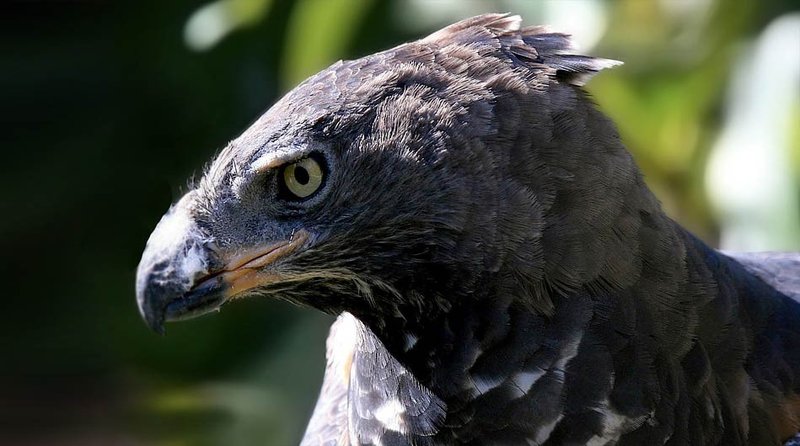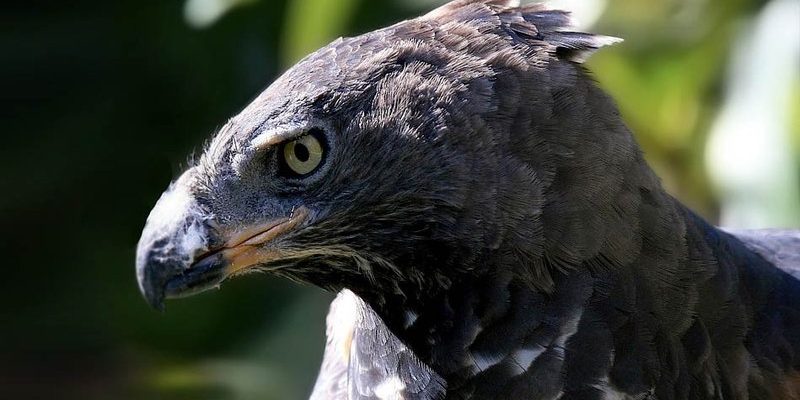
In this article, we’ll explore ten fascinating facts about the Crowned Eagle. Think of it as a warm coffee chat where we dive into the life of one of nature’s most incredible predators. We’ll cover everything from its hunting techniques to its habitat, revealing insights that might just surprise you!
1. The Crowned Eagle’s Habitat
The Crowned Eagle is mostly found in the tropical rainforests of sub-Saharan Africa. Just picture dense, humid jungles with towering trees and plenty of foliage. This environment provides excellent cover for the eagle to hunt and nest. They prefer areas with tall trees, as this height gives them a perfect vantage point for spotting prey.
Interestingly, they are also adaptable birds. While they thrive in forests, they can occasionally be seen in savannahs or wooded areas. These versatile habitats help them find food sources and escape from potential threats. If you ever get a chance to visit these regions, keep your eyes peeled—you might just spot one gliding above the treetops!
2. A True Apex Predator
When it comes to hunting, the Crowned Eagle is nothing short of a specialist. It primarily preys on medium-sized mammals, such as monkeys and small antelopes. Imagine a stealthy ninja swooping down to catch its lunch—that’s how they operate! Their incredible eyesight allows them to spot potential meals from great distances, and their powerful talons can crush bones with ease.
But here’s the thing: their hunting technique is something to marvel at. They often wait patiently in their trees, using their camouflage to blend in with the surrounding leaves. When an unsuspecting animal wanders too close, the eagle strikes with lightning speed. It’s a masterclass in patience and precision!
3. Strong Family Bonds
Crowned Eagles are also known for their strong family structures. They typically mate for life, which is pretty romantic for birds, right? They build large nests high in trees, made of sticks and lined with softer materials to keep their chicks cozy. Both parents share the responsibility of incubating the eggs and feeding the young ones.
Once the chicks hatch, they rely on both parents for food and protection. These family bonds are essential for the chicks’ survival, as they learn valuable hunting skills by observing their parents. It’s a heartwarming reminder of how important teamwork is, even in the wild!
4. Unique Physical Features
One of the most striking things about the Crowned Eagle is its appearance. With a wingspan that can reach up to 2.2 meters (about 7.2 feet), it’s an impressive sight in the sky. The dark plumage contrasted by a distinctive crest of feathers on its head makes it easy to identify.
These physical features aren’t just for show. That impressive crest can help them communicate during courtship rituals or when defending their territory. It’s like wearing a crown to announce their presence and prowess. Honestly, if I had a crown like that, I’d want to show it off, too!
5. Vocalizations and Communication
Speaking of communication, Crowned Eagles have a variety of vocalizations that they use to convey different messages. Their calls can range from high-pitched whistles to deeper, resonant sounds. You might be wondering how birds like these communicate so effectively.
During mating season or when defending their territory, these vocalizations become particularly important. The sounds help establish dominance and attract mates. It’s fascinating how something as simple as a call can play such a crucial role in survival and reproduction in the wild.
6. Conservation Status
Unfortunately, like many magnificent creatures, the Crowned Eagle faces threats to its population. Habitat loss due to deforestation and hunting has impacted their numbers significantly. They are currently classified as Near Threatened on the IUCN Red List.
Conservation efforts are underway to protect these majestic birds and their habitats. Organizations work to promote awareness and run programs aimed at preserving the rainforest ecosystems that these eagles call home. It’s important to support these efforts, as every species plays a vital role in maintaining ecological balance.
7. Cultural Significance
In several African cultures, the Crowned Eagle holds significant symbolic meaning. Many tribes view it as a symbol of power, nobility, and freedom. Imagine walking through a bustling market, and you see artwork or crafts featuring this majestic eagle. Its image often represents strength and bravery in various folklore.
This symbolism shows how deeply interconnected humans and nature can be. By respecting and protecting these birds, we also honor the traditions and stories that have been passed down through generations.
8. Lifespan and Development
Crowned Eagles can live quite a long time in the wild, with lifespans reaching up to 20 years or more. The journey from hatchling to full-grown adult is quite a process. After about two months in the nest, the chicks start to fledge, meaning they begin to learn how to fly. This spell of learning is crucial, as it prepares them for independence.
Here’s the thing—during the early stages of development, they are entirely dependent on their parents. It’s a vulnerable time, and their parents’ attentiveness plays a huge role in their survival. This dedication helps ensure that the next generation of these magnificent birds can take to the skies.
9. Differences from Other Eagles
Though they belong to the eagle family, the Crowned Eagle stands out in several ways. Unlike the more common Bald Eagle found in North America, the Crowned Eagle is much more elusive and is less often seen by the average person. It’s not just their hunting style that differs; their preferred environments and social behavior are unique as well.
For instance, while many eagles are solitary, Crowned Eagles are often found in pairs or family groups. These differences highlight the diversity within the eagle family and show just how varied avian life can be across the globe.
10. How to Spot a Crowned Eagle
If you’re lucky enough to find yourself in the Crowned Eagle’s habitat, spotting one can be an unforgettable experience. Here are a few tips to increase your chances:
- Look for tall trees where they might nest.
- Listen for their unique vocalizations, especially during the breeding season.
- Be patient and scan the skies for their distinct silhouette, especially during early morning or late afternoon.
With a little luck and a keen eye, you might just witness the grandeur of the Crowned Eagle in action.
In conclusion, the Crowned Eagle is not just any ordinary bird. It’s a stunning example of nature’s beauty and power. From its impressive hunting skills to its cultural significance, each fact we explored reveals why this eagle deserves our admiration and protection. So, the next time you think of eagles, remember the Crowned Eagle and all its remarkable traits. It’s truly a bird that embodies the spirit of the wild!

